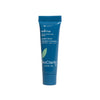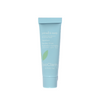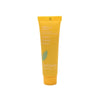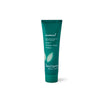Using Face Wash to Prevent Breakouts
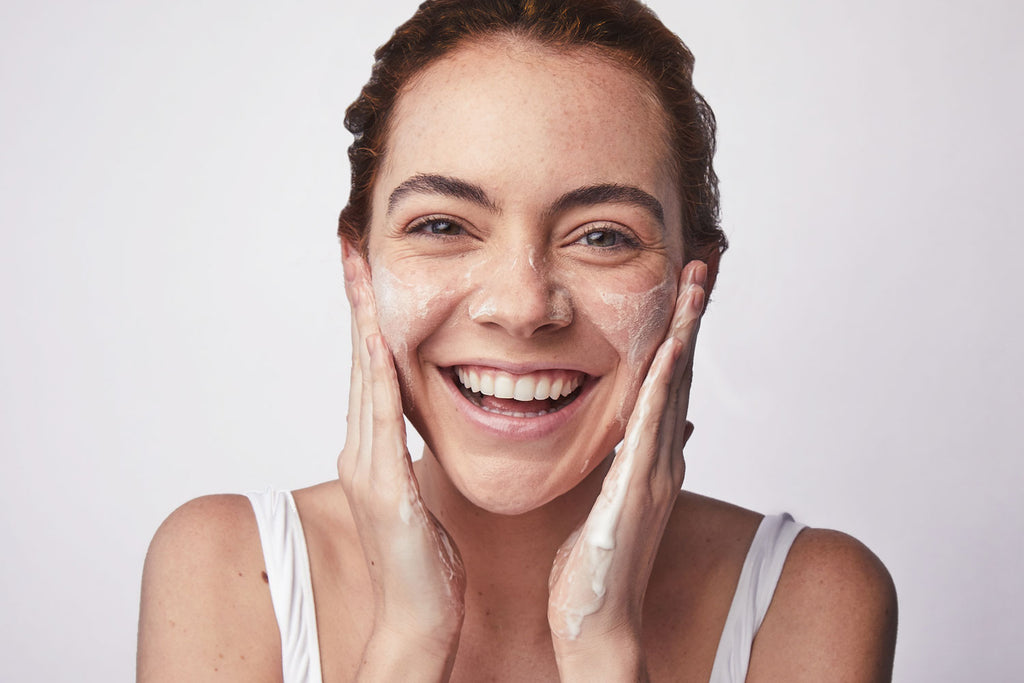
Acne is the most common skin condition in the United States, and at least 60 million Americans have active acne at any given time. Acne can develop in people of any age, but it’s more common in adolescents, young adults, and women.

Although extremely common, acne often causes a lot of physical and emotional distress for the people who suffer from it. Creams, gels, face masks, exfoliants, and do-it-yourself remedies are just a few of the treatments people use to rid their skin of blemishes. It can take years to find a method of managing your acne, which involves plenty of trial and error.
Face wash has long been used to help control and prevent acne blemishes. There are thousands of face washes on the market that assure you they can fix your skin’s flaws, but not all of them can deliver on their promise. There is no known cure for acne, but using the right products the right way can help you get healthy, clear skin.

Three Stages of Acne
Before you learn how to treat your acne with face wash the correct way, it’s crucial to understand how breakouts form. The development of acne is a complex process; various factors like hormones, genetics, bacteria, and lifestyle habits can affect your risk of acne. By the time a pimple has formed, your pore has gone through a long process of accumulating oil, dirt, and debris.

Stage 1: Pore Becomes Clogged
Acne is a type of skin disease characterized by clogged hair follicles. These clogs are formed when open pores fill with excess oil, bacteria, debris, and dead skin cells.Hair follicles appear as tiny dots on the surface of the skin. Each follicle contains a sebaceous gland, which produces an oil called sebum. This oil helps keep skin safe and healthy. The sebaceous lipids, or fats, contained in sebum are responsible for hydrating your skin and hair. These oils also help regulate your body temperature while you’re in hot or cold conditions. In warm climates, the oils keep the surface of the skin hydrated and regulate body temperature. When you’re in cold conditions, sebaceous oils help waterproof your skin to resist the moisture in rain and snow. Oil also prevents disease-causing microbes from entering the skin. While oil is critical to skin health, too much oil can lead to acne breakouts and other skin conditions. If oil builds up in the pores, it can trap dead skin cells and prevent them from sloughing off naturally.
Stage 2: Bacteria Infiltrates the Pore
When an open pore becomes clogged, it invites acne-causing bacteria to enter the skin. The main culprit behind acne breakouts is Propionibacterium acnes, also known as P. acnes. This bacteria is a type of microbe that lives deep within the hair follicles and pores, far beneath the surface of the skin. Some strains of this bacteria are responsible for protecting the skin from pathogens that can cause severe infections, but others have the potential to cause cellular damage beneath the skin, causing swollen bumps to form.
Although it’s a bacteria, P. acnes isn’t contagious and it can’t be contracted by others. Nearly everyone has a few strains of P. acnes bacteria on their skin, but some strains are more infectious than others. P. acnes grows optimally in the presence of lipids and in the absence of oxygen. Blocked pores limit oxygen to the follicle which causes sebum to build, creating the perfect breeding ground for more bacteria. When the pore is clogged with debris and oil, P. acnes becomes attracted toward the surface of the skin, and the nutrients absorbed from the pore causes the bacteria to multiply rapidly.
Other factors may lead this bacteria to create acne. Each individual has a distinct population of P. acnes strains that can cause breakouts and inflammation. If you happen to have a stronger strain of P. acnes, it may take advantage of your skin’s unique environment, and without effective immune defenses, infiltrate deeper into the skin to cause inflammation.
Some people are more susceptible to the effects of P. acnes than others. Because P. acnes survives off the lipids produced by sebum, oily skin is likely to attract more bacteria. Sebum production increases during puberty and other hormonally active periods, such as the menstruation cycle and pregnancy. Some medications can also elevate levels of sebum that attract bacteria. Excess sebum creates the ideal environment for P. acnes, and it will multiply within the hair follicles, which are deeper in the skin.
Genetics also play a role in how P. acnes effects skin. Genes can affect your natural hormone levels and immune system, which can in turn make your skin more or less resistant to acne-causing bacteria. If your parents or close relatives had acne at your age, you’re more likely to develop it as well. Your body needs to effectively kill off the bacteria in order to stay acne-free.
Stage 3: Inflammation Occurs
As sebum and bacteria continue to build, your body releases red and white blood cells to contain the infection and kill the bacteria. This results in the swelling and inflammation you experience during breakouts. If the bacteria isn’t killed off and continues to grow within the follicle, a pimple will form. Inflammatory acne occurs when pimples turn into papules, pustules, or cysts due to a bacterial infection. The skin surrounding the infected pore typically becomes red and swollen, which can be painful and warm to touch. These acne breakouts usually occur on skin surfaces that contain high amounts of sebaceous glands, including the face, upper back, and chest, but this type of acne can occur on other areas of the body as well.Breakouts don’t always occur because of acne-causing bacteria. Non-inflammatory acne is caused when excess oil and dead skin cells block the pore, but P. acnes bacteria isn’t present. This type of acne usually results in open and closed comedones, also referred to as whiteheads and blackheads, respectively.
Acne Scars
If your immune system effectively kills off the bacteria and heals your skin, you may experience torment long after the pimple disappears. This most often occurs due to the formation of acne scars. Acne scars are the result of deep acne lesions like cysts, pustules, and papules, occurring when a clogged pore leads to a P. acnes bacterial infection. A large acne lesion can swell to a size where it ruptures the walls of the hair follicle, causing cellular damage. When the pimple bursts, the blockage may damage other parts of the dermis before it dissipates.
If the pimple pops close to the skin’s surface, you may not form a scar. The deeper the infection goes, however, the more likely you are to develop acne scars, which may appear as crater-like formations and discolored spots on the skin. As the wound heals, your body repairs itself by sending collagen to the damaged area. While collagen does help repair skin, it can also cause the raised tissue characteristic of scars. If your skin loses some tissue, the skin from your lesion may feel thin and appear darker than the rest of your skin.
You can also develop scarring as a result of popping pimples yourself. Applying pressure to an inflamed pimple will cause it to burst, and cause damage in its wake. This is not a recommended way to get rid of pimples. If you have acne, it’s recommended that you don’t pop it yourself; let your body heal it on its own or use a prescribed treatment from a doctor to heal your skin.
A whopping 25 percent of young adults who get acne will develop permanent scars. If you have severe inflammatory acne and are beginning to develop scars, seek the help of a professional and resist popping it on your own.

Top 5 Face Washing Mistakes
Washing your face can help prevent and manage acne breakouts, but it’s crucial you wash it correctly to avoid damage. If you have a structured beauty regimen and you’re still experiencing acne, consider how you wash your face. Using the wrong cleansers, exfoliants, and water temperature can worsen your breakouts.
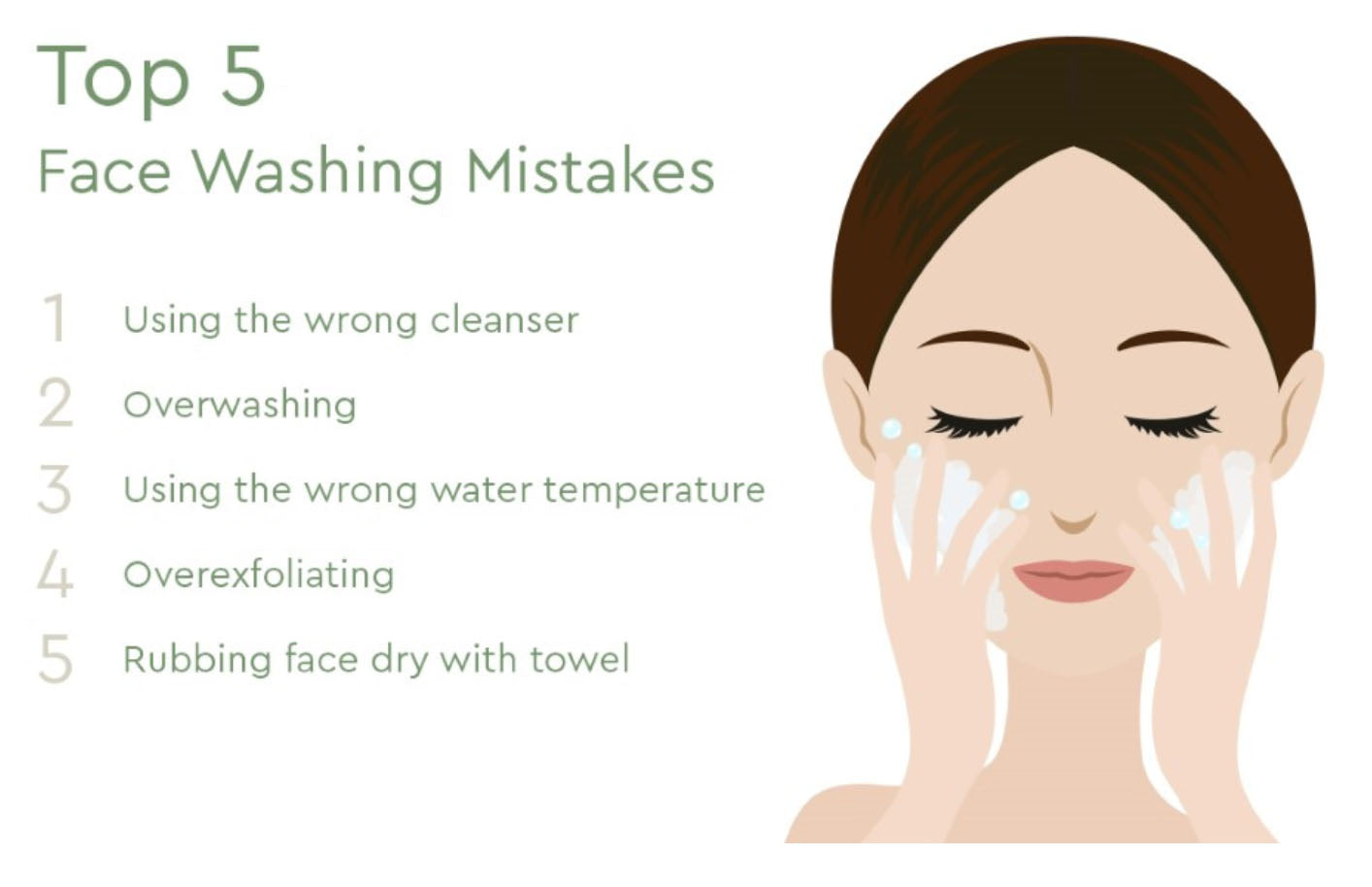
Mistake #1: Using the Wrong Cleanser
There are thousands of cleansers on the market promising to clear acne and brighten skin. The right cleanser can make or break your beauty routine by either making blemishes disappear, or aggravating the skin and making acne worse. We prefer a gentle, vegan cleanser that gently removes dirt, grime, and dead skin cells to make room for new skin cells, without drying out or irritating the skin. Knowing your skin type will help you choose the optimal cleanser.
- Normal skin: Like all skin types, normal skin goes through natural wear and tear throughout the day. Whether you go to the gym or you wear a lot of makeup, a good cleanser will help remove grime and debris that can potentially clog pores. In this case, don’t overdo it with facial cleansers. Choose a gentle product for normal skin to keep your complexion glowing and acne-free.
- Oily skin: Choose products with a low pH level in order to gently wash away excess oil without dehydrating skin.
- Dry skin: Avoid products with a heavy alcohol content. Alcohol dries the skin and can leave it itchy, irritated, and inflamed.
- Sensitive skin: Stay away from products that contain harsh, skin-irritating chemicals. Ingredients like fragrance and other additives can aggravate sensitive skin, leaving it itchy and inflamed. If you have sensitive skin, you may also want to test for allergies and avoid products that contain those ingredients.
Mistake #2: Washing Too Often
Your skin has natural oils that keep it moisturized and healthy. Washing your face too often can strip your face of its natural oil and leave your skin irritated and dry. How often you wash your face depends on your skin type. The common wisdom is to wash your face twice a day; however, this isn’t always the most effective method. Everyone has different skin, and considering your own skin type is a key step in determining how often you should wash your face. If you have excessively oily skin, you should consider washing your face once in the morning and once at night. For dry skin, stick to washing once daily before bed. Whatever your skin type, always gently wash your face after working out or performing strenuous activity. Whether you go to the gym or go for a run, foreign bacteria from the surrounding environment can mix with sweat and cause acne breakouts.
Remove your makeup before you wash your face. Some cleansers don’t remove makeup all at once, so make sure you choose a cleanser that effectively removes all of your foundation and concealer, especially around the eyes and the creases of the nose. Once makeup is thoroughly removed, splash water on your face to remove excess oil, dirt, and dead skin cells.
Mistake #3: Using the Wrong Water Temperature
Cold weather conditions can make skin itchy and dry, so it’s tempting to step into a hot shower on a chilly day. Many people believe that the steam from the hot water will hydrate their skin, but this isn’t true; hot water can make dry skin worse and cause burns. Skin contains specific proteins and fats, like sebum, that act as a protective barrier to lock in moisture and protect you from harsh weather. Going from a cold environment to a hot one, or vice versa, can throw your skin off balance by stripping it of its natural defenses.
Long or frequent showers can also irritate the skin by removing its natural oils. When the oils are stripped from the skin, it loses its hydration and becomes dry and irritated. Long, hot showers can make dry skin worse and contribute to the formation of acne; when too much oil is removed from the skin, the sebaceous glands will overreact by creating excess oil, even on oily skin types.
If you have acne-prone skin, steer clear of hot showers. People of all skin types should take cold to lukewarm showers for no longer than ten minutes to preserve the skin’s natural oils. For tighter, brighter-looking skin, take ice-cold showers. The cold water tightens the pores to seal in moisture and block dirt and debris from clogging the hair follicle.
Mistake #4: Exfoliating Too Much
Skin is constantly regenerating itself, replacing dead skin cells with new ones. Dead skin cells typically slough off on their own, but sometimes your skin needs extra help. The combination of skin cell build up, excess oil, and dirt can result in acne breakouts. When this happens, some people turn to exfoliates to help rid their skin of excess skin cells that are contributing to their breakouts.
Exfoliants can work to clear blemishes, but the products you use and how often you should use them depends on your skin type. Not all exfoliants are created equal; some contain ingredients that are best for your face, while others are better for the rest of your body. If you suffer from acne primarily on your face, you should use a gentle exfoliant sparingly. Harsh exfoliants with large granules will damage new skin cells, causing dryness, redness, and inflammation. If you have oily skin, this can also cause your sebaceous glands to overproduce oil, causing more acne to form. As a general rule, stick to exfoliating once a week for dry skin, or twice a week for oily skin.
If you have acne on your neck, chest, back, or other areas, tougher exfoliants may be appropriate. Unlike your face, the skin on many other parts of your body is thicker and can withstand larger granules. Areas on the body that are most prone to acne are those that constantly rub against clothing, like bra straps. Sweaty gym clothes can also cause acne if you don’t remove them and shower soon after a workout. Exfoliants can help keep your skin clear of blemishes in areas that are prone to acne, but just like with your face, use them sparingly so as not to damage your skin.
Mistake #5: Rubbing the Face Dry with a Towel
Like exfoliating, rubbing your face with a towel can cause harm to your complexion. When the tiny fibers of your towel rake across your skin, they can strip it of its natural oils and damage new skin cells. Reusing old towels can also spread bacteria and dirt on your face, causing more acne.
Instead of rubbing your face with a towel, pat it gently after you wash. This method will dry your skin without causing irritation, which is especially important for those with sensitive skin. Be particularly careful around the eye area; the skin here is thin and delicate, and harsh rubbing can cause discoloration, swelling, and wrinkles. When you dry your face, don’t reach for the same towel you used to dry off after your shower. Always dry your face with a clean washcloth or towel to prevent bacterial infection.
If you’re frustrated by acne breakouts that don’t seem to go away, changing your face-washing routine may help. Rejuvenate your skin and gain a radiant complexion by following these beauty tips.
So Gentle, So Foamy
Our fan fave, botanical-rich Cleanser banishes oil and ick without fighting dirty.
Keep it Clean
Abby Vinas
Abby Vinas has long been an active member of the holistic health community, advocating in favor of its benefits to both our physical and emotional well-being. Her commitment to leading a healthy lifestyle has made her an authority on self-care practices. Abby is passionate about fitness, nutrition, and proper skincare, and is also an avid lover of avocado toast and dog-petting.
